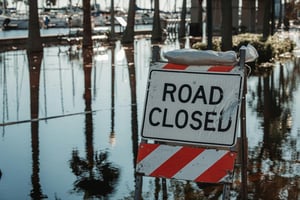With the 2024 Atlantic hurricane season less than two weeks away, it's crucial for insurance agents...
Climate Change is Changing the Math on Commercial Flood Risk
Floods are the most common and expensive natural disasters in the United States, and climate change is making them worse. A warming atmosphere holds more water, leading to heavier rainfall. Consequently, we are witnessing stronger, longer, and more frequent storms that are causing more intense floods. All this has knock-on effects for the business of flood insurance and its related costs to both businesses and insurers. Let’s take a closer look at some of the risks. One reason natural disasters like flooding are becoming more expensive is because we continue to build in areas that are high risk and what qualifies as “high risk” continues to expand.
.png?width=960&height=378&name=afr%20blog%20background%20(1).png)
In a 2020 study, the First Street Foundation, a non-profit research and technology organization studying, quantifying, and communicating about climate change risk, found that of the 14.6 million properties across the United States at substantial risk of flooding, around 40% of those (roughly, 5.9 million properties) are not in the Federal Emergency Management Agency’s (FEMA) designated floodplain. As for commercial real estate, Miami and New York City top the list with the most commercial structures at risk, with estimated damages coming in at billions of dollars; in Boston, more than 700,000 properties could be affected by flood damage with the tab coming in at over $16 billion by 2052.
But even as a huge portion of properties are at risk, population growth and urban expansion requires more land, and this often leads to building in riskier locations. Commercial development has increased in areas that are vulnerable to floods, and even in those areas that have seen flooding in recent years.
In 2022, for example, Hurricane Ian caused flooding not just along Florida’s Gulf Coast but also inland in districts that were not designated as ‘at risk’ at all; losses are estimated to be upwards of $50 billion. Yet as of May 2022, Florida, along with Arizona and Texas, had some of the fastest growing cities in the entire United States, and all three have areas that are also at high-risk for flooding.
As the number and intensity of natural disasters grow, so too does an insurance company’s pay out to policyholders, which is often disproportionate to what they collect in premiums. There were, for example, four separate billion-dollar flood events in the United States in 2016 but many affected by those events did not have flood insurance. Because costs continue to rise – and dramatically – premiums will increase as well, especially if insurers cannot transfer some of the excessive risk to the reinsurance market. A big enough flood, whether real or threatened, can put an insurer out of business.
In 2021, FEMA announced Risk Rating 2.0 to more accurately reflect flood risk in premiums. While FEMA says future climate change won’t affect a single year’s premium, increased flood risk due to climate change will lead to higher premiums. In the private flood markets, insurers are tightening, leading to some pulling out of certain areas more prone to flooding and, at the very least, increasing premiums.
For a better understanding of flood insurance and how climate change will impact flood risk, why not work with AFR? Our 30+ years in the flood business provides us with the tools and knowledge we need to work with you and your clients to find the best and most cost-effective flood insurance solutions.



